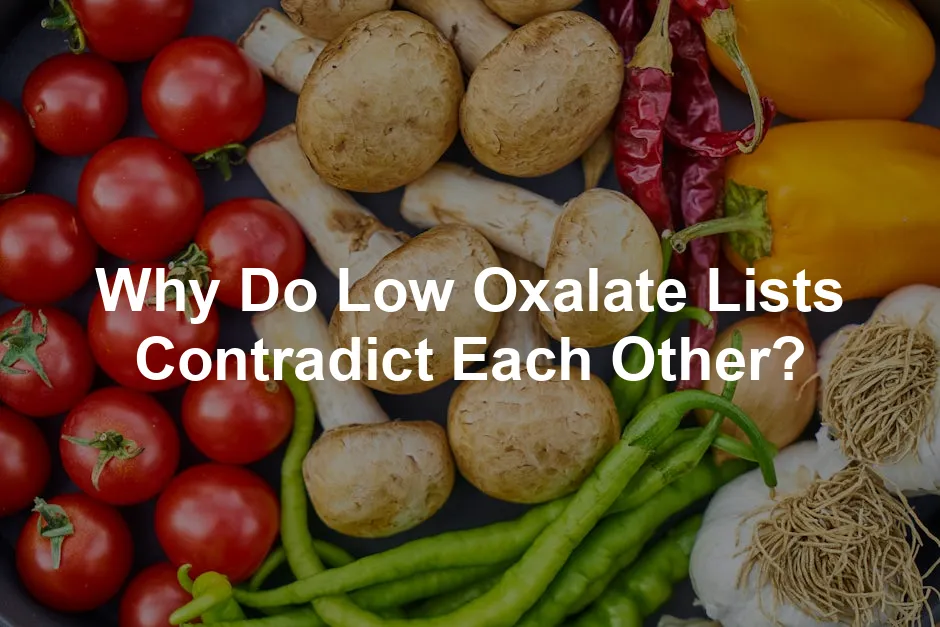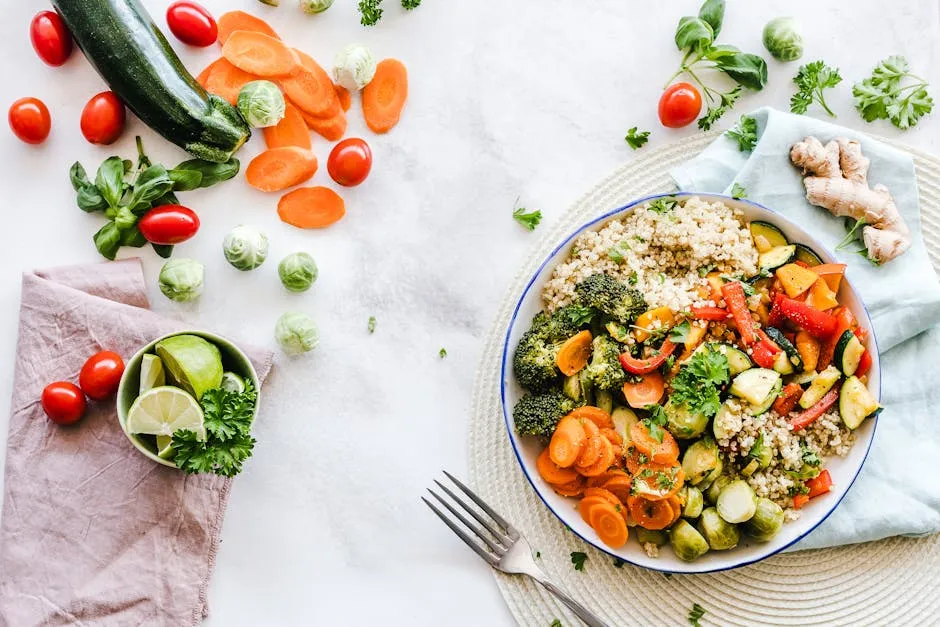
Why Do Low Oxalate Lists Contradict Each Other?
Why Do Low Oxalate Lists Contradict Each Other?
Low oxalate diets are vital for those at risk of kidney stones. These diets help prevent the formation of calcium oxalate stones. However, many food lists provide conflicting information about oxalate levels in various foods. This article aims to clarify why these contradictions occur and how to navigate them.
Understanding Oxalates
What Are Oxalates?
Oxalates, or oxalic acid, are organic compounds found in many foods, particularly plant-based ones. They occur naturally in foods like spinach, nuts, and chocolate. In plants, oxalates help manage calcium levels and deter herbivores. While oxalates have no nutritional value for humans, they can bind to minerals like calcium, potentially leading to kidney stone formation when consumed in excess. Understanding the oxalate content in foods is essential for those at risk of kidney stones.

Speaking of spinach, why not whip up some delicious recipes with a Low Oxalate Diet Cookbook? This book can help you navigate the tricky waters of low oxalate eating while still enjoying tasty meals. Who knew healthy eating could be so delicious?
Oxalates and Kidney Stones
Oxalates are compounds that contribute to the formation of kidney stones. When oxalates bind with calcium in urine, they can form calcium oxalate stones, the most common type of kidney stone. Risk factors for developing these stones include high urinary oxalate levels, dehydration, and insufficient dietary calcium. Individuals prone to kidney stones should monitor their oxalate intake closely. A diet high in oxalates may lead to increased urinary oxalate levels, raising the risk of stone formation. Maintaining hydration and balancing calcium intake can help in kidney stone prevention.
But how can you accurately measure your food to ensure you’re not overdoing it? A Food Scale for Accurate Measurements can be your best friend in the kitchen. It ensures you get the right portions every time, helping you keep your oxalate levels in check while enjoying your meals.

Conflicting Information in Low Oxalate Lists
Sources of Conflicting Information
Conflicting information about oxalate levels in foods often comes from various sources. Research studies, dietary guidelines, and online resources can all provide different data. Measurement methods can vary widely. Some studies analyze raw foods, while others assess cooked versions, leading to discrepancies. Additionally, the type of equipment used in these studies can influence results. Food preparation techniques, like boiling or soaking, can also reduce oxalate levels dramatically. These variations in methodology create challenges in providing consistent oxalate content data. As a result, individuals seeking to manage their oxalate intake may find themselves confused by the conflicting lists available.
To make meal prep easier, consider investing in a Glass Meal Prep Containers. These containers are perfect for portioning out your meals in advance and keeping everything organized. Plus, they help reduce food waste and make it easy to grab a healthy meal on the go!

Factors Influencing Oxalate Levels in Foods
Many factors affect oxalate levels in foods, making it challenging to establish consistent values. Environmental conditions, such as soil quality and climate, can significantly impact oxalate concentrations in plants. Different plant varieties may also produce varying levels of oxalates. Furthermore, food preparation methods, including cooking and soaking, can alter oxalate content. Cooking can help reduce soluble oxalates, as they may leach into cooking water. Therefore, understanding these variables is crucial for anyone looking to manage their oxalate intake effectively. Keeping these factors in mind can help individuals make informed dietary choices.

If you’re interested in exploring more cooking methods, consider a Cooking Pot with Steamer Insert. This handy tool allows you to steam vegetables effortlessly, preserving their nutrients while reducing their oxalate content. Cooking can be a breeze with the right equipment!
Dietary Considerations and Recommendations
Navigating Conflicting Lists
Conflicting information about low oxalate diets can be frustrating. To make sense of these discrepancies, consider a few practical tips. First, personalize your diet based on your unique health needs. Everyone’s body reacts differently to oxalates, so what works for one person may not work for another.
Consulting a healthcare provider or nutritionist is crucial. They can help you interpret conflicting lists and guide you on what foods suit your individual needs. Look for dietary guidelines that emphasize a balanced approach rather than strict limitations. This ensures you don’t miss out on essential nutrients.

Keep a food diary to track how different foods affect your health. Remember, it’s about finding a sustainable path that works for you, rather than adhering rigidly to one list.
Common Misconceptions About Low Oxalate Diets
Many myths surround low oxalate diets, leading to confusion. A common misconception is that all oxalate-rich foods are harmful. In reality, many foods high in oxalates also provide vital nutrients. For example, spinach and almonds are often considered healthy despite their oxalate content.
Excessively limiting dietary oxalate can lead to nutritional imbalance. This restriction may deprive you of essential vitamins and minerals, ultimately affecting your overall health. Instead of focusing solely on oxalate content, aim for a balanced diet that includes a variety of foods.
Healthy eating should prioritize moderation. It’s not just about oxalates but overall nutrient intake. Embrace a diverse diet while being mindful of your oxalate consumption to maintain good health.

FAQs
What foods are high in oxalates?
Common high-oxalate foods include spinach, rhubarb, and almonds. These foods can impact health, particularly for those prone to kidney stones. It’s important to be aware of oxalate content while ensuring a balanced diet. Many high-oxalate foods also offer essential nutrients, so moderation is crucial.
How can I manage my oxalate intake effectively?
To balance oxalate consumption, aim to incorporate more calcium-rich foods. Calcium binds with oxalates in the gut, reducing absorption. Additionally, staying well-hydrated can help dilute oxalate levels in urine. Consider keeping a food diary to track your intake and consult a nutritionist for personalized strategies.
Are low oxalate diets necessary for everyone?
Not everyone needs a low oxalate diet. Individuals with calcium oxalate stones or high urinary oxalate levels may benefit most. However, those without these conditions can often enjoy a varied diet, including moderate amounts of oxalate-rich foods, without significant risk. Always consult with a healthcare provider for tailored advice based on your health needs.
Can Cooking Affect Oxalate Levels in Foods?
Cooking methods can significantly impact the oxalate content in foods. Notably, boiling or steaming vegetables can help reduce soluble oxalates. When you cook these foods, oxalates may leach into the cooking water. Discarding this water can lower the overall oxalate levels you consume.

Additionally, methods like soaking can also be beneficial. Soaking grains or legumes before cooking may decrease their oxalate concentration. This is particularly true for foods like beans and lentils. By using these preparation techniques, you can enjoy a variety of foods while managing your oxalate intake more effectively.
Is There a Reliable Source for Oxalate Content in Foods?
Finding trustworthy sources for oxalate content in foods can be challenging. Many lists are available online, but they may not always be accurate. For reliable information, consider using resources like the Harvard T.H. Chan School of Public Health‘s website. This site provides updated and well-researched oxalate food lists.
Another excellent option is the Kidney Stone Diet website, which offers detailed information on oxalate levels in various foods. When searching for dietary resources, look for those backed by scientific studies or authored by registered dietitians. This can help you make informed choices about your diet and manage your oxalate intake effectively.
And while you’re at it, consider getting a Digital Meat Thermometer. It’s perfect for ensuring your meats are cooked to perfection, eliminating guesswork and keeping your meals safe and delicious!
Please let us know what you think about our content by leaving a comment down below!
Thank you for reading till here 🙂
All images from Pexels




